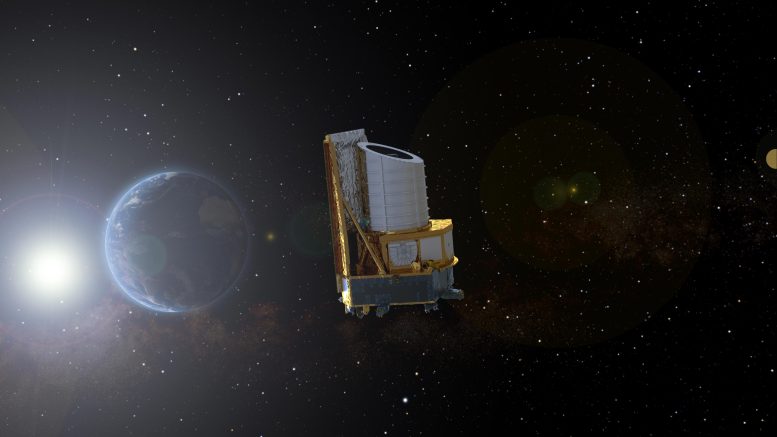
This artist’s impression shows Euclid leaving Earth and on its way to Sun-Earth Lagrange point L2. This equilibrium point of the Sun-Earth system is located 1.5 million kilometers from Earth in the opposite direction of the Sun. L2 revolves around the Sun along with Earth. During Euclid’s orbit at L2, Euclid’s sunshield always blocks the light from the Sun, Earth and Moon while pointing its telescope towards deep space, ensuring a high level of stability for its instruments. Credit: ESA
If you think it’s only possible to be held in orbit around a physical ‘thing’ with a large mass – a planet or a star, say – you’d be wrong. It is in fact possible to orbit around an invisible point, an oasis of forces, infinitesimal in size. ESA’s Euclid mission was launched on July 1, 2023, to uncover the secrets of the dark universe. Its destination? Like many astronomy missions before it, Lagrange point 2.
The following animation, created using “Gaia Sky,” shows Euclid’s path from Earth to this unique and useful position in space. Located about 1.5 million kilometers from Earth in the opposite direction from the Sun, the second Lagrange point (or Libration point) is about four times farther away than our Moon.
Euclid spent about a month getting to ‘L2’, where it recently arrived and will remain for a planned six years in orbit. From L2 it will study the mysterious nature of dark matter and dark energy that make up 95% of our Universe, but about which very little is known.
What are Lagrange points?
Lagrange point 2 is one of five Lagrange points located in fixed positions around the Sun and Earth. Truly points, they are themselves invisible, infinitesimal in size, and created where the gravitational pull of two large bodies creates a ‘centripetal force’ that enables a body in these locations to rotate with them.
This balancing out of ‘push’ and ‘pull’ forces results in five gravitational oases in the vicinity of any two massive moving bodies. As such, satellites in orbit around Lagrange points require much less work, and fuel, to remain in place here.
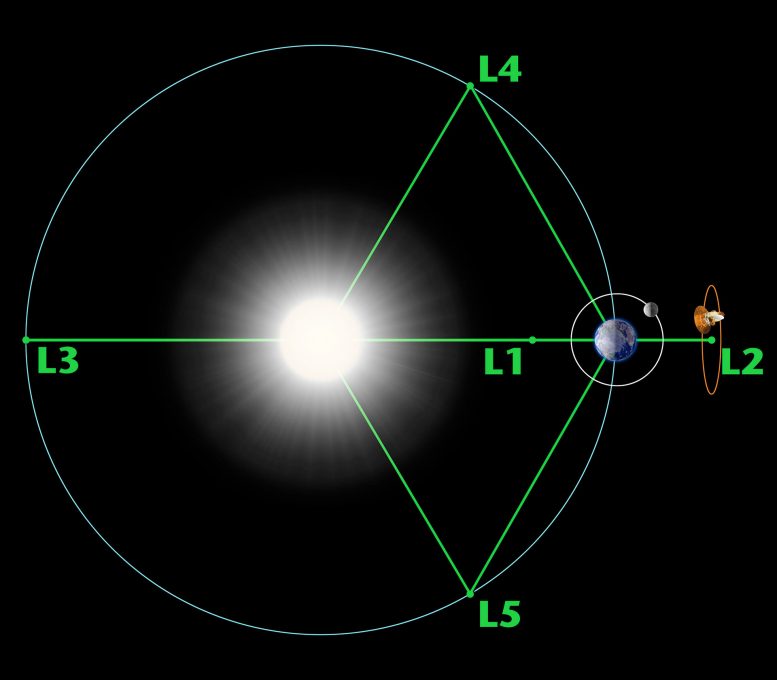
The Lagrange points associated with the Sun-Earth system. Lagrange Points are positions in space where the gravitational forces of a two-body system like the Sun and the Earth balance out, allowing a spacecraft to remain in position with reduced fuel consumption. The image includes a small icon representing NASA’s WMAP spacecraft orbiting around L2, which is about 1.5 million km from Earth. ESA missions orbiting Lagrange points include: ICE, LISA Pathfinder and SOHO at L1, and Herschel, Planck, Gaia at L2. Future ESA Lagrange point missions include JWST, Euclid and Plato (L2), while a study is under way for a future space weather mission at L5. Note: Image is not to scale. Credit: NASA/WMAP Science Team
In an ideal world, spacecraft would remain in orbit here forever, without any help at all. However, like resting a pencil on your finger, the reality is a little different. Mathematically, both should be easy, but just as the wobble caused by a person breathing can cause the pencil to topple, unpredictable factors in space mean that spacecraft too can begin to wander.
One primary factor is the ‘breathing’ of our Sun. Solar Radiation Pressure – literally the small force exerted on objects by light photons – is unpredictable but has a real effect. Every four weeks, a small maneuver will be commanded by controllers on the ground at ESA’s mission control center in Germany, to maintain Euclid’s orbit.
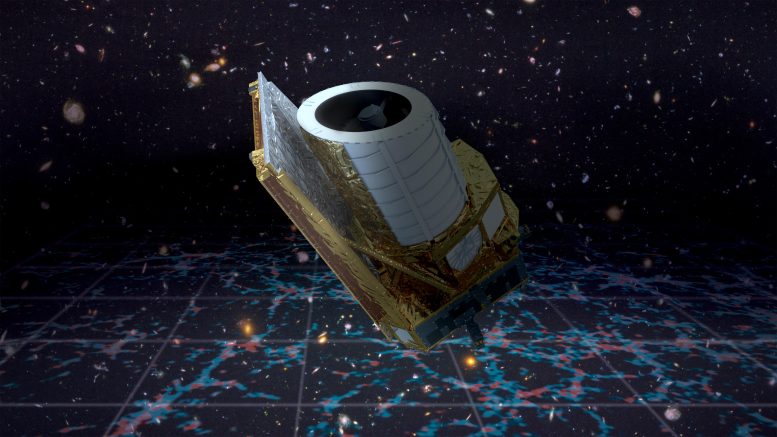
ESA’s Euclid mission is designed to explore the composition and evolution of the dark Universe. The space telescope will create a great map of the large-scale structure of the Universe across space and time by observing billions of galaxies out to 10 billion light-years, across more than a third of the sky. Euclid will explore how the Universe has expanded and how structure has formed over cosmic history, revealing more about the role of gravity and the nature of dark energy and dark matter. Credit: ESA/Euclid/Euclid Consortium/NASA. Background galaxies: NASA, ESA, and S. Beckwith (STScI) and the HUDF Team
Why ‘L2’?
The second Lagrange point is ideal for astronomy missions because they can keep the Sun, Earth, and Moon behind them at all times, so they don’t interfere with observations, while at the same time getting a clear view of deep space and pointing an antenna back to Earth to remain in close communication.
The permanent sunlight on Euclid at L2 also keeps the telescope thermally stable, allowing for the extremely high stability required for the instrument’s long exposure observations.
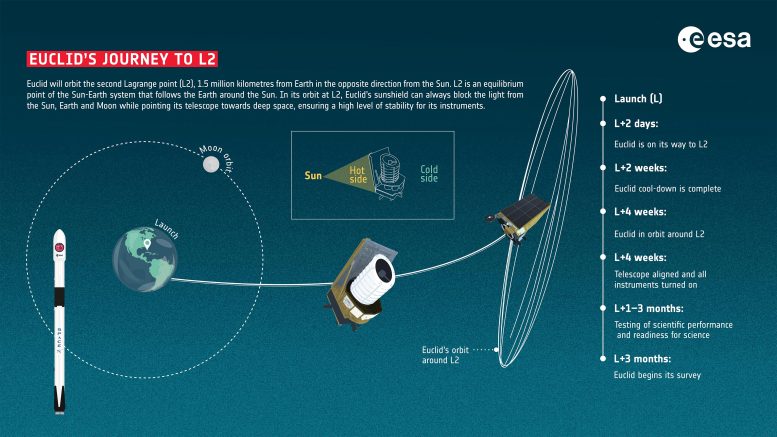
ESA’s Euclid will orbit the second Lagrange point (L2), 1.5 million kilometers from Earth in the opposite direction to the Sun. L2 is an equilibrium point of the Sun-Earth system that follows Earth around the Sun.
In its orbit at L2, Euclid’s sunshield can always block the light from the Sun, Earth, and Moon while pointing its telescope towards deep space, ensuring a high level of stability for its instruments.
At L2, Euclid joins ESA’s Gaia mission and the ESA/NASA/CSA James Webb Space Telescope, which are also orbiting around this equilibrium point, each following well-separated trajectories. Credit: ESA
Euclid’s orbit around Lagrange point 2 is big, bigger than the Moon’s path around the Earth. In fact, by the time Euclid has completed one full revolution around L2, the Moon will have circled the Earth six times. In terms of distance, the ‘radius’ of Euclid’s orbit varies from about 400,000 kilometers (250,000 miles) at its closest to the center, and up to 800,000 kilometers (500,000 miles) at its farthest.
The reason for this large orbit is that it is almost free, in terms of fuel, to get there. The better the accuracy of the rocket that launches a mission into such a large halo orbit around L2, the less fuel that’s needed to perform correction maneuvers – and Euclid only required a tiny correction maneuver after its launch on a Space X Falcon 9.
In the month after its launch on July 1, Euclid has traveled 1.5 million kilometers from Earth towards the Sun-Earth Lagrange point L2, meaning it has ‘arrived’ at its destination orbit. This animation showcases the orbits of Euclid (green), the James Webb Space Telescope (blue), and the Gaia mission (yellow) around this unique position in space. The positions of the spacecraft in this animation don’t correspond to their current positions in space. Credit: ESA/Gaia/DPAC
How will Euclid’s mission end?
Despite its distance, the second Lagrange point is considered an Earth orbit. As such, missions here are bound by international regulations on the sustainable use of space.
ESA, also in line with its own Zero Debris commitment, has designed a disposal maneuver so that once Euclid’s mission is over, it will be directed into heliocentric orbit – the same orbit as Earth’s around the Sun. For at least 100 years, the probability of Euclid entering back into the Earth-Moon system will be very, very small. By then, it may be possible to make use of such valuable metals in space!
Euclid will be ESA’s fifth mission at Lagrange point 2. Joining the Gaia observatory and NASA/ESA James Webb Space Telescope, it also follows in the orbits of Herschel and Planck, to shed light on the mysteries of our Universe.
Gaia Sky is a real-time, 3D, astronomy visualization software that runs on Windows, Linux, and macOS. It is developed in the framework of ESA’s Gaia mission to chart about 1 billion stars of our Galaxy in the Gaia group of the Astronomisches Rechen-Institut (ZAH, Universität Heidelberg).



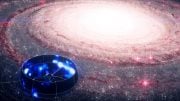

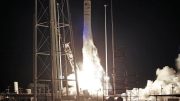

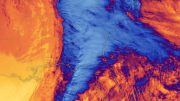
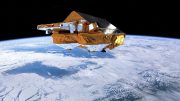
Be the first to comment on "Dark Universe Explorer: Euclid’s Large Halo Orbit Around Infinitesimal Point"